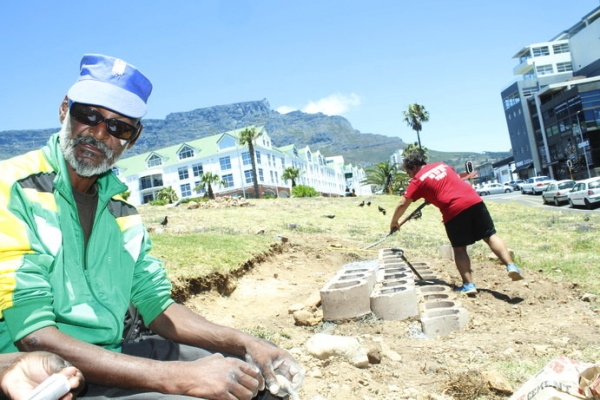Inner city revamp to benefit street people

Trees are to be planted in the open space off Canterbury Street in the city centre as part of a project designed to improve the lives of street people and others using the area. The project includes a mural on the wall of the Fruit and Veg City store to which street people will contribute.
The project, funded by Khulisa Social Solutions, involves engineering students from the US working with street people in the area.
Lenny Gqwaru, 29, who has lived in the street for almost four years, came up with the idea for the painting, based on the hand prints of people who use the area.
“When I was briefed on the idea, I thought of street people, people who park their cars at the open space and the people who buy from Fruit and Veg City. I thought anyone wishing to do so could dip their hands in paint and press them against the wall,” says Gqwaru.
“The project is part of a bigger project to improve the lives of everyone who makes use of this parking area. It will include all vulnerable people in the area,” said Alicia Weber, one of the students working on the project.
Next to the mural, a poem by Theresa Alexander, who has lived on the street for three years, will be inscribed.
It reads:
Without hope there is no today
Without love there is no community
Without you we are nothing.

“The mural painting is amazing. We feel street people are being recognised by the community,” says Alexander.
On the land which slopes from Fruit and Veg City to Canterbury Street, students and street people are working on a “Memory Terrace” built of hollow bricks filled with compost and soil. The plan, Weber said, was to commemorate the lives of street people by planting a flower in one of the containers every time a street person died.
Achmat Salie, who once worked as long distance truck driver but is now living in the street said: “It is a good idea that street people are being recognised and remembered by the community. We actually feel we are part of the community.”
Salie has lived on the street for close to 20 years. He survives from money paid by car owners who park in the area.
Part of the project involves planting trees to offer shade to the street people and the cars they guard..
“It is our aim to create inclusive spaces that allow all to participate: people living on the streets, the business community, residents, even those that have passed on. The memory terrace also wishes to acknowledge the presence of District six people who were forcibly removed,” said Jesse Laitinen, Khulisa strategic manager.
Meanwhile street people are also exhibiting their art at the Service Dining Room in Canterbury Street.
Gideon Harris, 58, who has lived in the street for 15 years, is one of the exhibitors.
“After we have been lost and forgotten in the streets such projects put us back in the light. We as street people are happy to show our skills and be part of the community,” said Harris.

Support independent journalism
Donate using Payfast

Don't miss out on the latest news
We respect your privacy, and promise we won't spam you.

This article is licensed under a Creative Commons Attribution-NoDerivatives 4.0 International License.
